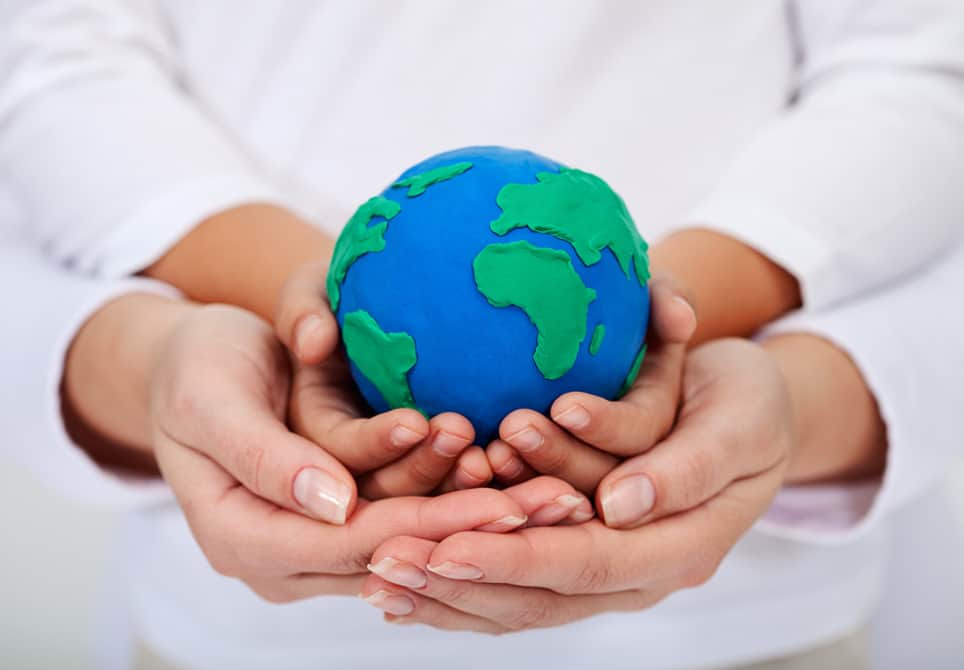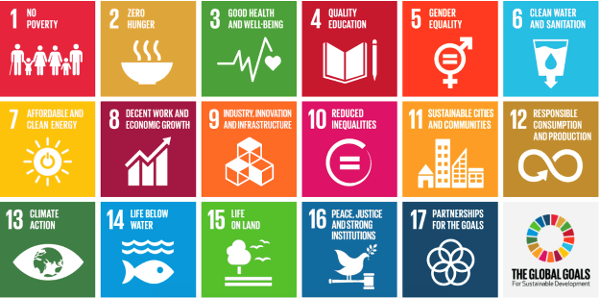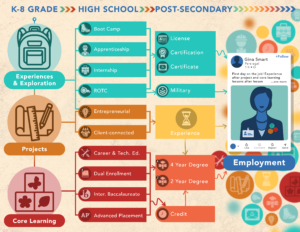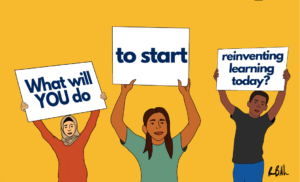Earth Owner’s Manual: 17 Things Young Adults Should be Studying

As a species, we’ve made a good deal of progress recently but we’ve also created a pile of problems that young people will inherit. We owe them at least an overview of what they’re in for.
Conservative colleagues encourage a content-rich approach to education but suggest a mostly rear view mirror course-based approach (founding documents and all). It’s important to know where you came from, but it’s also important to understand where you’re headed.
Advocates for student-centered learning suggest letting student interests drive the content that teaches skills and concepts. That’s great, but let’s create high agency environments by exposing secondary students to the owner’s manual for the planet they will inherit.
Last September, the UN General Assembly adopted the 2030 Development Agenda titled Transforming our world: the 2030 Agenda for Sustainable Development. A subsequent campaign resulted in 17 Global Goals that provide a roadmap for a better future.
The goals could be incorporated into the framework for a high school or college degree program or at least a couple courses. If you want a content-rich and a relevant and applied course of study, the Global Goals are a good starting point.
With some additions from Gates Foundation sponsored Grand Challenges and the National Academy of Engineering Grand Challenges, following are 17 goals that young people should grapple with as core learning experiences in secondary and tertiary education.
1. No Poverty. By 2030, reduce at least by half the proportion of men, women and children of all ages living in poverty. Key will be equipping more people for high contribution tasks and providing a living wage for those in low skill services.
2. Zero Hunger. End hunger, achieve food security and improved nutrition and promote sustainable agriculture.
3. Good Health and Wellbeing. Ensure healthy lives and promote wellbeing for all at all ages.
While Zika and Ebola get all the news coverage, last year there were about 214 million cases of malaria cases and 438,000 malaria deaths. Morbidity is down 60% since 2000 but the disease burden in places like Sub-Saharan Africa remains enormous.
For those of us in the west, cancer sucks. While the “cure for cancer” that Obama mentioned in the state of the union is unlikely in the near term, it is likely that environmental, behavioral and diagnostic routines can reduce morbidity substantially.
Despite progress in reproductive health in the developing world, “Many women, couples and adolescents do not or are not able to access information, supplies and services that could facilitate preventing unplanned pregnancies and planning the number and timing of desired pregnancies,” according to Gates’ Grand Challenges. Like many challenges, family planning is a complex topic involving behavior, culture, policy and technology.
A systematic approach to collecting and managing health information can enhance medical care and public health response effectiveness. For individuals, Precision Medicine seeks to identify genetically-based drivers of disease in order to develop new, more effective treatments.
The big emerging policy question is the increasing ability to predict genetic features and even conduct genetic enhancements. Now that we can alter the code of life, how will we use it?
4. Quality Education. Ensure inclusive and equitable quality education and promote lifelong learning opportunities for all.
5. Gender Equity. Achieve gender equality and empower all women and girls.
6. Clean Water and Sanitation. Ensure availability and sustainable management of water and sanitation for all. About 1 out of every 6 people living today do not have adequate access to water, and more than double that number lack basic sanitation, for which water is needed.
7. Affordable & Clean Energy. Ensure access to affordable, reliable, sustainable and clean energy for all.
8. Decent Work & Economic Growth. Promote sustained, inclusive and sustainable economic growth, full and productive employment and decent work for all.
9. Industry, Innovation & Infrastructure. Build resilient infrastructure, promote inclusive and sustainable industrialization and foster innovation. As the majority of the world’s population crowds into 50 megacities, it poses particular infrastructure challenges, especially in Asia. Basic infrastructure is still a significant need in many countries. “America’s infrastructure, along with those of many other countries, is aging and failing, and that funding has been insufficient to repair and replace it,” according to the National Academy.
10. Reduce Inequality. Reduce inequality within and among countries. To promote equity and opportunity, young people should understand the political system, advocacy and social change strategies, and should develop their own change leadership skills.
11. Sustainable Cities & Habitats. Make cities and human settlements inclusive, safe, resilient and sustainable. Ensure sustainable consumption and production patterns. During our three year Smart Cities investigation, we found a community of scientists, sociologists and technologists committed to livable, workable, sustainable cities (check out #SmartCities).
12. Climate Action. Take urgent action to combat climate change and its impacts. The planet is warming, sea levels are rising and weather events are becoming more unpredictable. This appears to be a largely man made phenomenon and one that, if we act quickly, we may be at least partially mitigate. (Last week, the first “climate refugees” were relocated in the U.S. and an expected climate exodus from parts of MENA).
Challenges include making solar economical, continuing the progress Al Gore notes in his recent TED talk. Progress could come from new breakthroughs in artificial photosynthesis (mentioned by President Obama in the state of the union). Other important challenges are carbon sequestration and managing the nitrogen cycle.
13. Life Below Water. Conserve and sustainably use the oceans, seas and marine resources for sustainable development.
14. Life On Land. Protect, restore and promote sustainable use of terrestrial ecosystems, sustainably manage forests, combat desertification and halt and reverse land degradation and halt biodiversity loss.
15. Peace, Justice & Strong Institutions. Promote peaceful and inclusive societies for sustainable development, provide access to justice for all and build effective, accountable and inclusive institutions at all levels.
16. Smart and Safe Technology. Quietly and steadily algorithms have improved your life. Pedro Domingos, University of Washington, notes, “They find books, movies, jobs and dates for us, manage our investments, and discover new drugs.” Narrow artificial intelligence powers chatbots on Facebook and beat the best Go player in the world. At some point in the 2030s many experts predict that smart AI will challenge human intelligence. After that comes super AI and things get a lot better…or worse. Either way, it will dramatically reshape the employment landscape our children and grandchildren experience (see Tim Urban’s discussion: part 1 and part 2). All students need to understand computer science principles and be ready to work, live and thrive in a technology-centric, AI and IoT world of the future.
Physical attacks associated with terrorism will continue but pale in comparison to the economic risks associated with cybersecurity breaches in public data systems, transportation routing systems, and power grids. The National Academy said, “It is clear that engineering needs to develop innovations for addressing a long list of cybersecurity priorities. Bioterrorism and rogue nukes are a related threat, and will almost certainly involve a cybersecurity problem.”
17. Partnerships For the Goals. Strengthen the means of implementation and revitalize the global partnership for sustainable development.

Education: Key to #GlobalGoals
The sleeper goal on the list is #4, education. Eric Hanushek argues that the most important determinant of economic growth is the “knowledge capital” of nations, which they define as the aggregate skills of the country’s population and which they measure by achievement scores on international mathematics and science examinations. In other words, learning is key for accomplishing all of the other goals. Improving education would help reduce poverty, to improve health and potentially reduce inequities.
In order to participate in the idea economy (#9) and project-based world young people need to know the basics of enterprise, entrepreneurship and behavioral economics. They need experiences that develop an innovation mindset, a productive disposition that combines:
- Growth Mindset: Applied intelligence is not fixed, it expands with effort.
- Maker Mindset: Recognizing opportunity and taking initiative.
- Team Mindset: Collaborating with diverse teammates.
To promote equity and opportunity (#10), young people (like students at Chavez Schools in Washington DC) should learn about the political system and effective advocacy strategies, and the opportunity to develop their own change leadership skills.
If we take citizenship preparation seriously, we should be encouraging young people to engage with the world’s user manual. But most of these goals don’t fit neatly into the master schedule and they are not on anyone’s test.
Capstone projects in the last two years of high school are a good place to start. Each academy at Reynoldsburg High School engages in a triple block capstone project. Students at Singapore American School are required (starting 2018) to conduct a capstone project.
“If we really want to develop creators, thinkers and innovators in the next generation of learners, let’s design high school programs that focus on The Global Goals for Sustainable Development,” said Nate McClenning, Vice President for Education and Innovation at Teton Science Schools. Nate suggests, “Using place-based education to engage students locally around these goals will both strengthen communities and develop learner capacity to address global challenges and opportunities.”
The mission of the Workshop School in Philadelphia to “unleash the creative and intellectual potential of young people to solve the world’s toughest problems.” They put real world problems at the center of the curriculum and evaluate student work based how well they define, explore and develop solutions to those problems.
Networks of project-based high schools (New Tech Network, Big Picture, Envisions, Edvisions) help students develop a series of applied and integrated projects that lead to development of valuable knowledge and skills. Similarly, a network of Global Goals schools could facilitate a sequence of goal focused projects; learner supports could include writing tutorial and problem solving seminars. Cycling through the Global Goals could provide an interesting and applied approach to physical and life science. Thoughtful prompts that link Goals to the exploration of historical cause and effect could be an interesting and applied approach to history.
Foreign travel can be transformative. “International experience, language abilities, time spent abroad, etc. – these are all skills and experiences I would want young adults to have in order for them to have the skills and capabilities to navigate this shrinking planet and solve our planetary challenges,” said Gates Foundation program officer Rahim Rajan. “At a time when knowledge is increasingly more specialized, the skills and capacities to work across geographies and borders become ever more important.”
A low risk approach would be for a big high school to launch an upper division academy (a microschool with two teachers and 40 students) that, over the course of two years, would allow students the opportunity to address many of the Global Goals through projects.
Why not make Global Goals central to the high school and college course of study? We might just improve our chances of ending poverty, combating climate change and fighting inequality.
Stay in-the-know with all things EdTech and innovations in learning by signing up to receive the weekly Smart Update. This post includes mentions of a Getting Smart partner. For a full list of partners, affiliate organizations and all other disclosures please see our Partner page.






0 Comments
Leave a Comment
Your email address will not be published. All fields are required.